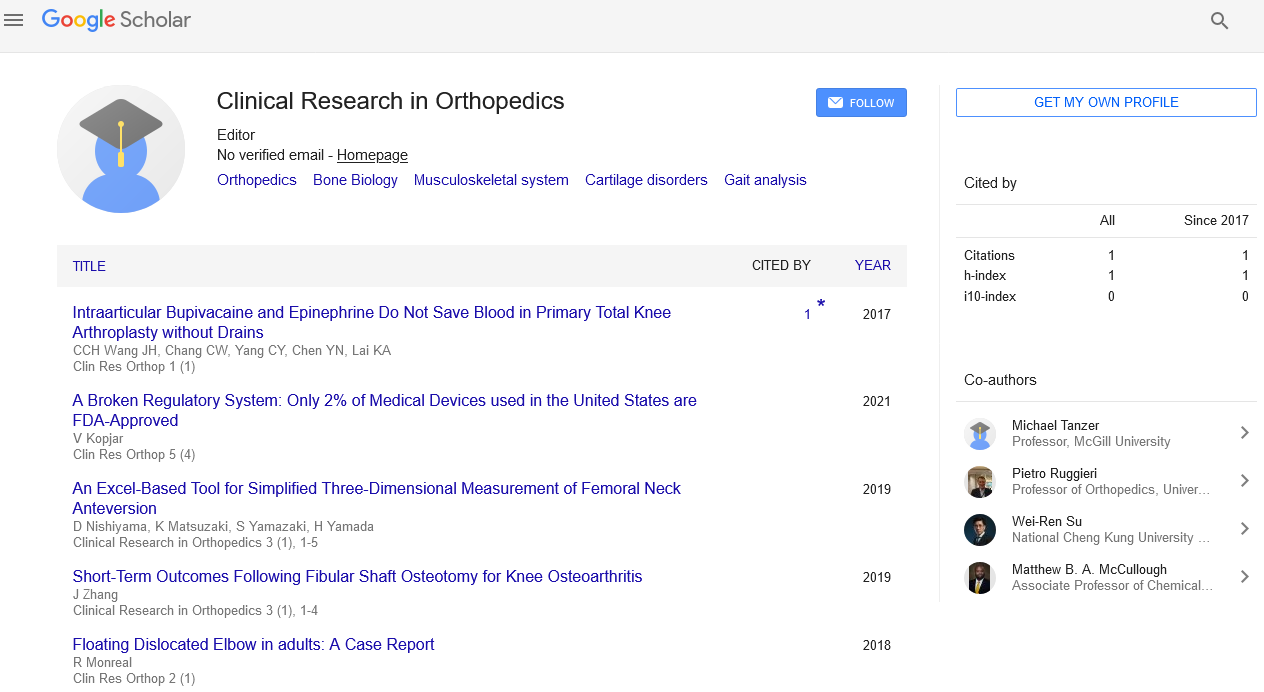The final frontier - Repair and functional restoration
Malcolm R Hooper
Oxymed, Australia
: Clin Res Orthop
Abstract
Almost 20 to 30 per cent of the body’s consumption of oxygen occurs within 3 to 5 per cent of the body mass – the brain and spinal cord structures. These structures are extremely sensitive to oxygen deficiency and benefit from oxygen repletion. The final frontier in the treatment of degenerative neurovascular disorders is focused on ‘repair and functional restoration’. This involves the use of neural growth factors to promote axonal sprouting, activation of idling and non-functional neurons whilst promoting neovascularization (new capillary formation) of the damaged (penumbra) areas. Cells in a chronic hypoxic state overexpress pro-inflammatory cytokines including IL1, Il6, IL7, IL8, IL17, TNFa, MMP9, S100B. The smoldering ‘cytokine storm’ differs for each individual. Over expression of proinflammatory cytokines inhibit neuroplasticity and neurogenesis and promote secondary apoptotic cascades. The extent of both primary and secondary neurovascular deterioration can be significantly diminished with HBOT, which ‘expands the therapeutic window’. “Hyperbaric Oxygen Therapy creates a ‘fertile neurovascular platform’ for emerging stem cell, immunotherapies and nanotechnology techniques. The impact and success of these and future procedures are dependent on the integrity of the underlying supporting neurovascular bed.” (Hooper 2005). The benefits of HBOT in rehabilitation are well documented. Hyperbaric tissue oxygenation results in increased blood flow by fostering the formation of ‘new capillary dynamics’ (neovascularization) into the damaged regions of the body. Hyperbaric tissue oxygenation accelerates neuroplasticity, activating damaged and dormant nerve cells (penumbra state). Increased Oxygenation significantly accelerates the rate of healing, stabilization and repair through numerous immune modulating effects, providing upregulation of anti-inflammatory cytokines, including: Granulocyte Macrophage Colony Stimulating Factor (GM-CSF), Interleukin-3 (IL3), Interleukin-4 (IL4), Interleukin10 (IL10), Interleukin-13 (IL13), Interleukin-21 (IL21), Brain Derived Neural Growth Factors (BDNF, GDNF), Vascular Growth Factors (VEGF), TGFβ Signaling and IGF1.From the American Journal Physiology, Heart and Circulatory Physiology (2005): Stem Cell Mobilization by Hyperbaric Oxygenation reports a single two hour exposure to HBOT at 2 ATA doubles circulating CD34+ progenitor stem cells (primordial cells targeted to salvage and restore damaged structures). At approximately 40 hours of HBOT, CD34+ cells increase eight-fold (800 percent). LOKOMAT Robotic Gait Assisted Walking is a sophisticated exoskeleton technique where the patient is fitted with a harness, suspended from the wheel chair and strapped into the exoskeleton. The LOKOMAT kinetic settings can be varied and specifically adjusted throughout the training session to “match the specific requirements of the individual”. Some patients have high level spasticity and others have a complete loss of tone. Robotic assisted training can be constantly adjusted to provide numerous accurate repetitions necessary to restore activity, especially walking function for neurologic patients. Improving a patient to the point that he or she no longer needs a wheelchair to move leads to reducing the economic burden associated wheel chair-associated complications that include pressure ulcers, circulatory disorders, osteoporosis and attendant care. LOKOMAT provides excellent opportunity to ‘best-fit’ a patient’s specific capabilities and capacity to re-train function. LOKOMAT Gait Training not only improves the gait in neurological patients, it also positively effects cardiovascular performance and reductions in spasticity, bone loss and associated bladder or bowel complications.
Biography
Malcolm R Hooper is an International Executive Director serving on both the International Hyperbaric Medical Foundation (IHMF) and the International Hyperbaric Medical Association (IHMA). He is a regular speaker at international symposiums on the topic of Hyperbaric Oxygen Therapy applications in the modern era.
E-mail: info@oxymed.com.au
 Spanish
Spanish  Chinese
Chinese  Russian
Russian  German
German  French
French  Japanese
Japanese  Portuguese
Portuguese  Hindi
Hindi 